Risk Assessment, Strategy and Tactics
Section 3: Risk Assessment, Strategy and Tactics
Section Contents
Section 3: Risk Assessment, Strategy and Tactics ............................................................................................ 1
Act
Risk Assessment, Strategy and Tactics .............................................................................................................. 1
3.1 The decision-making hierarchy ................................................................................................................. 1
3.2 Incident action planning ............................................................................................................................ 7
3.3 Selecting STRATEGY: key principles ..................................................................................................... 20
3.4 Selecting tactics and tactical modes ....................................................................................................... 22
3.5 Safe Person Concept .............................................................................................................................. 30
3.6 Dynamic Risk Assessment ..................................................................................................................... 34
3.7 Snap rescue ............................................................................................................................................ 42
3.8 Sectorisation ........................................................................................................................................... 44
3.9 The NZFS Agency Action Plan (AAP) ..................................................................................................... 50
Information
Official
the
under
Released
January 2013
i
Act
Information
Official
the
under
Released
Risk Assessment, Strategy and Tactics
Section 3: Risk Assessment, Strategy and Tactics
Introduction
This document is Section 3 of the New Zealand Fire Service (NZFS) Incident
Management – Command and Control Technical Manual.
Act
Risk Assessment, Strategy and Tactics
3.1 The decision-making hierarchy
3.1.1
It is important to understand that effective decision-making has to occur at a
Information
number of levels if an incident is to be managed successfully. Emergency
services personnel will use a wide range of methods for arriving at decisions,
but whatever the method, they must arrive at a clear understanding of:
• AIM
• STRATEGY Official
• TACTICS
• Operational TASKING.
the
3.1.1.1 AIM
The AIM is a concise, clear and simple understanding of the eventual outcome,
based on the NZFS Mission Statement.
‘What do we want to achieve?’
under
Released
January 2013
1
Incident Management – Command and Control
3.1.1.2 STRATEGY
The STRATEGY is the most effective, efficient and safe approach available to
us within the limitations of our resources and skills.
‘What we need to do’.
Examples of possible strategies are:
• Prevent property damage (smoke and water)
• Rescue occupants
• Administer first aid
Act
• Extinguish the fire
• Not extinguish the fire
• Restrict access/evacuation
• Protect the environment
• Firefighter safety.
3.1.1.3 TACTICS
The TACTICS are the specific actions we need to take to make our
Information
STRATEGY work.
‘How we go about it’.
Examples of possible tactics are:
• Offensive internal fire attack
Official
• Defensive external fire attack
• Salvage
the
• Formalise C&C
• Ventilation
• Establish water relay
• Cordon area
under
• Supported search and rescue BA teams
• Set up triage
• Decontamination.
3.1.1.4 Operational
Operational TASKING is the detailed decisions concerning the tasks that need
TASKING
to be performed to make the TACTICS work.
Released ‘Doing it’.
Examples of possible tasking are:
• BA crew no 1, low pressure delivery, 2nd floor, internal fire attack
• Salvage and ventilation crew, ground floor, with salvage sheets, restrict
water damage.
2
New Zealand Fire Service – National Training
 Risk Assessment, Strategy and Tactics
3.1.2
Risk Assessment, Strategy and Tactics
3.1.2
Decision-making on the incident ground is an example of hierarchical thinking
with everything deriving ultimately from the AIM. The model shown in Figure
3.1 below illustrates this hierarchy.
Act
Figure 3.1: Decision-making Hierarchy
Information
(Source – NZFS 2006)
3.1.3 Example scenario
There is a tendency to assume that all incidents are governed by the single AIM
‘to save life and protect property,’ and that we need not do any more thinking
than that. In fact the AIM (and the STRATEGY and TACTICS that flow from
it) may need to be more specific, or perhaps broken into staged priorities. The
Official
simple scenario below illustrates this.
3.1.3.1 Location
The location is a multi-gallery city arts museum. The museum houses
the
collections of regional paintings and sculpture of local interest but of no
exceptional value. The building, however, is 120 years old and listed as being
of heritage value. Operational planning focuses primarily on saving the
building as a priority rather than preventing possible damage to the contents.
3.1.3.2 Situation
In addition to its usual displays, the Museum is currently showing a travelling
under
exhibition of six paintings by Picasso in an upstairs gallery. The paintings are
irreplaceable and their monetary value is conservatively estimated at around
NZ$80,000,000. Unfortunately the NZFS was not advised regarding the
exhibition and has not amended its risk plan in any way.
Fire has broken out on the ground floor. Two galleries and the central staircase
are well involved. There is no lift. The picture galleries are not sprinklered
because of the risk of water damage to paintings. Fire is gaining ground
rapidly. Smoke is building up on the upper floor. Pre-determined attendance is
Released for 3 pumps. Additional resources are not likely to arrive for 10 to 15 minutes.
On arrival the OIC is met by the near hysterical Museum Manager, who tells
him that everybody has been evacuated from the building but the virtually
priceless Picasso paintings are still inside because nobody can get past the fire
on the staircase. The paintings may well already be suffering smoke damage.
January 2013
3


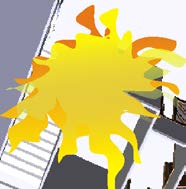
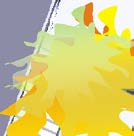
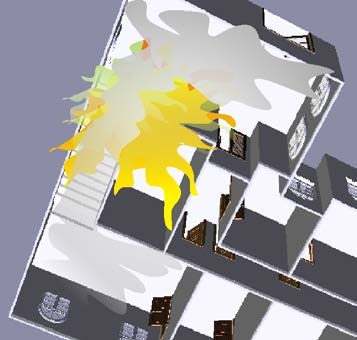
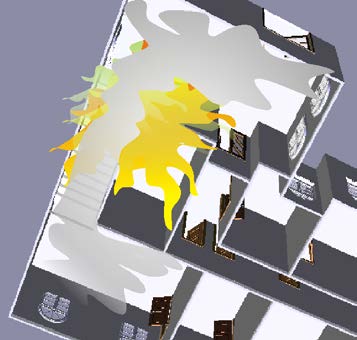

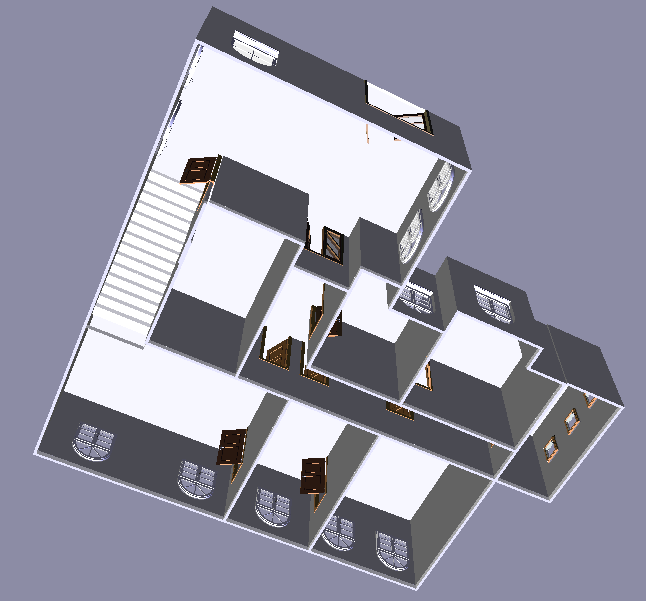
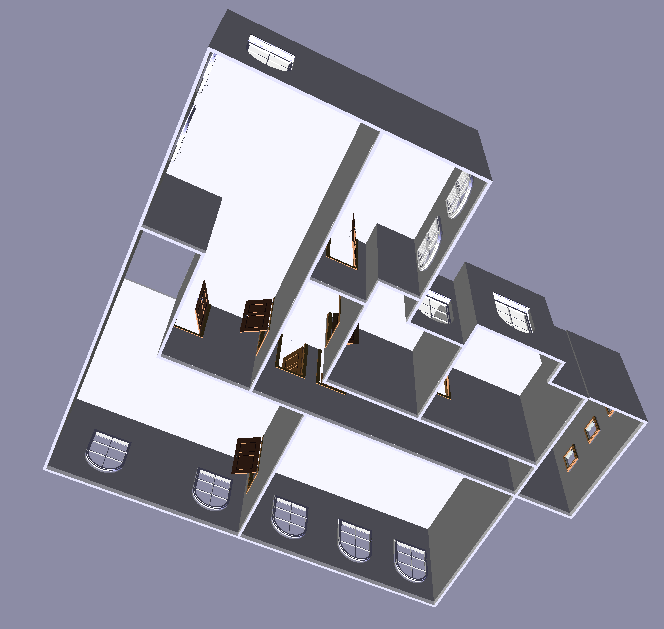
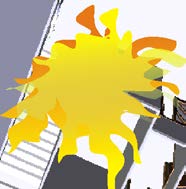

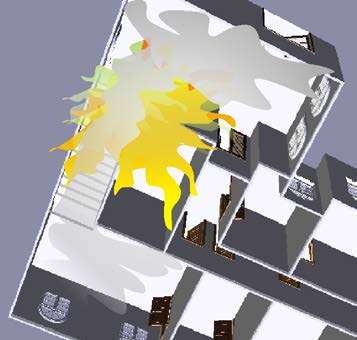
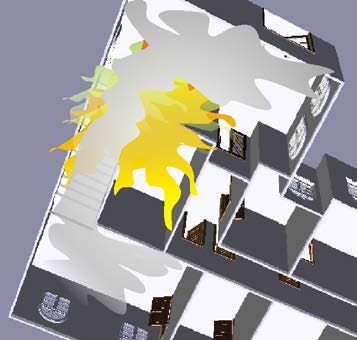
 Incident Management – Command and Control
Grou
o n
u d
n F
d l
F oo
o r
o
Fi
F rst F
t l
F oo
o r
o
Picasso
casso
exhi
h bi
b ti
t on
o
n
ga
g llery
Incident Management – Command and Control
Grou
o n
u d
n F
d l
F oo
o r
o
Fi
F rst F
t l
F oo
o r
o
Picasso
casso
exhi
h bi
b ti
t on
o
n
ga
g llery
Act
Stai
t rcase
Stai
t rcase
to
t u
o p
u p
p e
p r
ga
g lleries
En
E tran
r
ce
Information
Figure 3.2: Scenario – Fire in arts museum, Ground and First floor views
(Source – NZFS 2006)
3.1.4 Example AIM
This situation probably calls for the (temporary) abandonment of the
operational plan. Instinct directs you to attack the fire immediately, but you
have few resources and must think clearly to prioritise what you really need to
Official
achieve. As a general rule, the AIM can be stated in one sentence:
My AIM is to ‘Rescue’ the Picasso paintings before damage can occur, and
the
then save the remainder of the building.
3.1.5 Example
STRATEGY is usually expressed in non-technical terms.
STRATEGY
My STRATEGY is to use all initially available resources (1 crew) for the snap
rescue of the paintings with all possible speed, then attack fire with all
under
resources as they become available.
3.1.6 Example TACTICS
TACTICS are the methods selected to successfully carry out the STRATEGY.
At this point things usually become more technical, but can still be expressed
simply. Some of the terms discussed here will be further explained later in this
section.
My TACTICS are to:
Commence a search and rescue for the paintings in the first floor Picasso
Released gallery, supported by an interior cut-off.
When sufficient resources are available, commence an interior attack on the
ground floor to knock down the fire. Retreat to exterior attack if required.
Incoming resources to assist according to situation on arrival.
Undertake ventilation and salvage as required.
4
New Zealand Fire Service – National Training
Risk Assessment, Strategy and Tactics
3.1.7 Operational
The Operational TASKING component of incident management is essentially
TASKING
the specific allocation of resources to the various aspects of the TACTICAL
plan.
An operational task includes:
3.1.8
• The person (and crew size) to whom the task is being allocated
• Whomever that person will report to (e.g. Sector Commander)
• The location of the task (may include a grid reference)
Act
• The priority level assigned to the task
• The risk associated with the task
• An indication of when the task was commenced (to indicate when relief
should be implemented).
or
Task
Location
Team Leader No in
Sect
Grid
Crew Tasked at:
Information
3 Search and rescue for Picasso
Top floor rear.
G9/ SFF Smith
2
13:00
paintings and pass out window Access via ladder.
2
to museum staff
3 Interior cut-off to protect
Top floor rear.
G9/ SFF Brown
2
13:02
search and rescue team.
Access via ladder.
2
3 Interior attack to extinguish fire Ground floor.
G9/ SFF James
2
13:03
Official
before extending up the stairs
Access from front
1
entrance.
Ventilation and salvage starting Ground floor
G9/ SFF Smith
2
13:10
the
on the ground floor
1
under
Figure 3.3: The Operational TASKING process (example)
Released
January 2013
5
Incident Management – Command and Control
3.1.9
The tasks are captured regardless of the availability of current resources. The
list reflects what is already deployed, as well as a ‘wish list’ of resources that
are required to deal with the incident. The tasks are prioritised according to
their importance. This method is referred to as ‘planning backwards’. Figure
3.4 describes this method.
With an incident such as the scenario cited above, this would all be done
mentally, and accompanied by verbal instructions, due to the absolute urgency
and relative simplicity of the situation. However, as incidents grow in scale and
complexity there will be an increasing need to document the management Act
process. This is covered in more detail in later sections.
To minimise misunderstanding and confusion, it is important to understand the
terminology being used. In much the same way that the terms ‘dash roll’ and
‘roof flap’ became synonymous with techniques for vehicle extrication, terms
such as ‘Offensive Interior Cut-Off’ are being introduced to general
firefighting for the same reasons.
The process of determining operational tasking will highlight resource
requirements (make up requirements) and the risks associated with each task.
Using this process may in fact (and often does) require more tasking to be
Information
deployed. For example, the risk associated with an offensive Interior Attack on
a building with a high fire loading will require higher supervision,
communication and back-up. Each of these tasks draws down the resources
available.
3.1.10 Devolving
The first arriving officer at a small-scale incident will retain the
Official
responsibility
responsibility for strategy, tactics and most operational decisions until
relieved by a more senior officer from his/her District. However, if the
incident warrants additional resources, the Incident Controller will need
the
to think about delegation of command decision-making once these
arrive.
3.1.11
As the span of control hierarchy grows, the Incident Controller should delegate
as much of the lower level decision-making as possible. This is essential if
under
he/she is to retain overall ‘big picture’ responsibility for strategy and tactics,
leaving the lower level operational decisions to crew leaders.
3.1.12
Consequently, as more resources are deployed, the Incident Controller should
use other officers to share the burden of tactical decision-making. With large-
scale and prolonged incidents he/she should increasingly delegate tactical
decisions, e.g. to FIRE OPS and perhaps to Sector Commanders.
3.1.13 Key concept
The ability to delegate in accordance with incident scale and available
Released resources is a fundamental attribute of effective command.
6
New Zealand Fire Service – National Training
Risk Assessment, Strategy and Tactics
3.1.14 Risk assessment
Risk assessment is the process by which potential strategy and tactics are
– The Safe Person
subjected to analysis to determine whether or not the level of risk they
Concept
represent to operational personnel is acceptable. This is a process that
continues throughout the management of an incident and is consequently
referred to as ‘dynamic,’ i.e. constantly changing.
The process begins immediately on arrival, and at that stage may have to be
performed very rapidly. For example, when arriving at a fire with ‘persons
reported’, the OIC must decide very quickly whether or not to commit
firefighters to a snap rescue. There is a very real tension here between the need
Act
for urgency and the need to ensure the safety of personnel. Making an
appropriate decision under considerable stress is never easy. Officers must be
thoroughly conversant with the principles of the Safe Person Concept, which
will enable them to prioritise clearly in these situations. This is discussed in
greater depth later in Section 3.5.
3.2 Incident action planning
Information
3.2.1 Overview – From
Officers and firefighters will respond to most incidents on the basis of
experience
experience – they have seen this kind of incident before and know what is
required to deal with it successfully. Very little planning is required. In these
situations the OIC scans his/her ‘mental filing cabinet’ and when he/she
recognises strong patterns of similarity pulls the file. This is clearly a very
efficient, and perhaps the only means of decision-making when under severe
Official
time pressure. Experience and training combine to fill the filing cabinet.
3.2.2
Decision-making of this kind is referred to as ‘recognition primed decision-
the
making’ (RPDM). It is an entirely natural process and is often referred to as
‘naturalistic decision-making’. Nevertheless it must be balanced by the obvious
merit of giving situations some fresh thinking and avoiding the ‘automatic’
response. For a full explanation of RPDM see Klein (1998).
3.2.3 As a process
The RPDM model tells us that when we are faced with situations we have not
under
encountered before (i.e. there is no appropriate file in the filing cabinet) a more
structured approach is required. This is especially true when the situation is
highly complex and decision-making must take account of many variables. The
OIC should then resort to a decision-making process that is structured to take
account of variables in a disciplined and appropriate order.
Released
January 2013
7
Incident Management – Command and Control
3.2.4
Figure 3.4 illustrates a proven model for arriving at the most effective Incident
Action Plan (AAP/IAP) for NZFS led incidents (this is not necessarily the
process that other agencies will follow). The model consists of a number of
processes that result in outcomes which in turn enable subsequent processes.
Order and structure are essential for success. This does not mean that
individual processes could not be delegated, e.g. in the context of the CIMS
IMT – but the various components would have to be integrated in correct
process order.
3.2.5
Each process within the model is explained further in the following pages.
Act
Information
Official
the
under
Released
8
New Zealand Fire Service – National Training















 Risk Assessment, Strategy and Tactics
Process
Size Up
- 360 observation
- information gathering
- hazard identification
- potential for escalation?
Risk Assessment, Strategy and Tactics
Process
Size Up
- 360 observation
- information gathering
- hazard identification
- potential for escalation?
Act
Outcome
Essential data for developing the
plan.
Process
Plan backwards. What resources
are needed to deal with the full
potential of this incident?
w
s
s
ie
Outcome
Strategy development and tactical
v
e
Information
c
plan.
re
ro
s
p
u
o
ic
Process
Translate to Make-Up requirement.
u
m
- What does this mean?
a
- Greater alarm level + specials?
tin
Official
n
n
- Command assistance / SME’s
y
o
C
- d
the
Outcome
Resource plan.
under
Process
Priortise actions and tasks.
- Refer to RECEO
- Life, Property, Environmental
Outcome
Fire Service Action Plan.
Figure 3.4: Structured process for fire incident action planning
(Source NZFS 2006)
Released
Figure 3.4: AAP/IAP Planning Model
January 2013
9

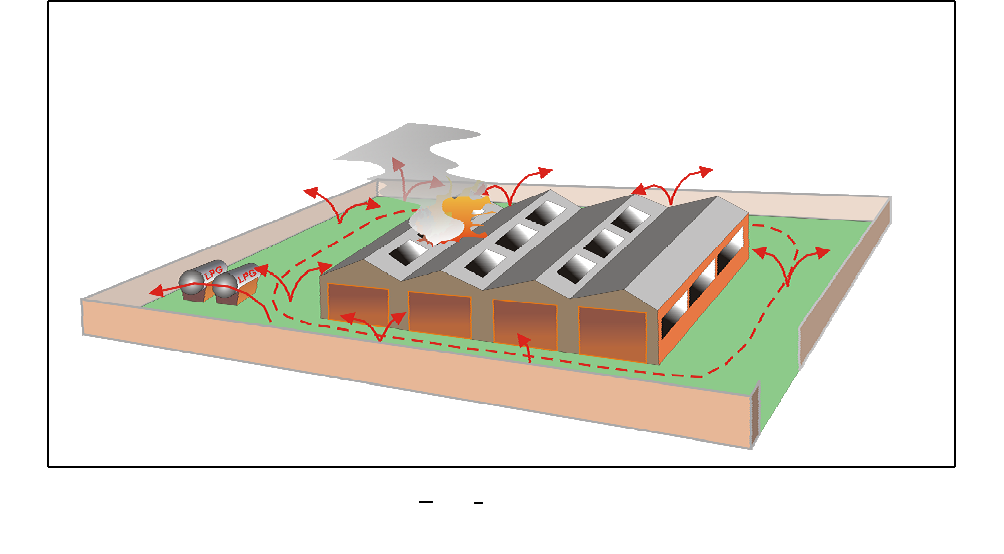 Incident Management – Command and Control
3.2.6 NZFS Agency
Incident Management – Command and Control
3.2.6 NZFS Agency
‘Size-up’ is an assessment, usually by the OIC, of the various factors that
Action Plan (AAP) –
impact upon the incident in question. This involves, as far as possible, an
Size-up
assessment of the whole incident site. Failure to grasp the whole situation may
lead to strategic or tactical errors (or indeed to pursuing an inappropriate aim).
The need for urgent action (e.g. search and rescue) will often be a legitimate
but significant distraction from the wider tasks of size-up. Consequently, the
OIC should delegate as many immediate actions as possible to his/her
firefighters, within the limits of their competence. For example, a size-up of a
significant fire at a tank farm may reveal one person needing rescue, but also
Act
the potential for major explosions. With ensuing widespread damage and
injury, the Incident Controller must prioritise where his/her attention should be
primarily focussed. The rescue task must be delegated to allow the incident
controller to attend to the bigger picture.
Size Up
- 360 observation
- information gathering
- hazard identification
- potential for escalation?
Information
Information gatheri ng through size-up must attempt to assess the whole
incident site. Failure
to do this may lead to ineffective planning and response.
3.2.7 360° observation
Whenever possible, officers should always conduct a 360º assessment (i.e. do a
complete circuit around the incident, or at least as much as possible).
Alternatively, obtain information from others who are better positioned. Figure
Official
3.5 below illustrates the 360° principle.
the
under
Figure 3.5: 360° assessment
(Source – NZFS 2006)
Released
10
New Zealand Fire Service – National Training
Risk Assessment, Strategy and Tactics
3.2.8 Information
Officers must realise that the key to effective decisions on the incident ground
gathering
is in seeking and processing useful information. Obtaining this information is
never straightforward, but is much easier with an understanding of what
information is needed.
This requires an understanding of ‘access opportunities’ – windows of
opportunity through which information can and should be gathered. This
process continues throughout the incident and ensures that previously gathered
information is validated and updated as progress is made.
3.2.9 BSAHF
Act
BSAHF is a memory aid to read a fire. It stands for:
•
Building
•
Smoke
•
Air track
•
Heat
•
Flame
3.2.10 BSAHF – Building The type, age and purpose of a building can inform firefighters about the type
Information
of fire that they could encounter inside.
3.2.11 BSAHF – Smoke
Smoke is a useful indicator of the intensity of the fire as well as what type of
substance is on fire
3.2.12 BSAHF – Air Track Read the air track with the neutral plane. A sudden change in the air track can
be a sign of flashover. Official
Lazy flowing air tracks show good oxygen supply and erratic air tracks show a
fire searching for oxygen.
the
No air track shows a fire in decay or a contained fire burning its available
oxygen.
3.2.13 BSAHF – Heat
Heat can show the stage and fire intensity as well as the type of fuel.
under
3.2.14 BSAHF – Flame
Lengthening flame signals gases approaching their LFL (lower flammable
limit).
Red flame is a sign of energy-rich fuels or fuels burning close to their UFLs
(upper flammable limit). Yellow flame is seen with normal-energy fuels or
fuels burning close to their LFLs.
Released
January 2013
11
Incident Management – Command and Control
3.2.15 Access
Information relevant to any given incident may be gathered from a wide range
opportunities
of sources, to make risk assessments, strategies and tactical options for that or
similar locations. Useful (perhaps vital) information can be gathered:
• Pre-incident – through risk planning, topographical knowledge, liaison
with key personnel at the potential incident ground, local emergency
plans, site visits etc.
• Pre-incident – through understanding of NZFS policies and Operational
Instructions
• En-route – through contact with the Comcen, other appliances, other
agencies etc.
Act
• On the incident ground – through effective 360° assessment
• On the incident ground – from bystanders, wardens, casualties,
evacuees, or employees fleeing the building, other rescue service
personnel etc.
• On the incident ground – through sensory data – i.e. what you and
others can see, hear, smell, or feel. For example, there may be closed
curtains, shoes at the front door, the smell of petrol, lights turned on, a
car in the garage, establishment of interior building layout from outside
(360° assessment), signage (e.g. HazChem)
Information
• Post-incident – through lessons learned from operational debrief,
analysis and reporting.
3.2.16 Hazard
When gathering information, either directly or through other personnel, the
identification
identification of actual and potential hazards must be at the forefront of the
Official
OIC’s mind. Failure to identify a hazard may result in inadequate risk
assessment and thus place firefighters or other attending personnel in danger.
the
The presence of hazards does not necessarily impede operations, but if they are
significant they must be eliminated, isolated or minimised. The logging (or
verbal notification) of the hazard and the selected mitigation strategy should be
communicated to staff at the incident and captured in the Hazard Register
section of the AAP.
under
Released
12
New Zealand Fire Service – National Training
 Risk Assessment, Strategy and Tactics
3.2.17 Potential for
Risk Assessment, Strategy and Tactics
3.2.17 Potential for
Whenever possible, the OIC should aim to move from being reactive
escalation
(responding to the incident as it develops) to being proactive (predicting how
the incident will develop and bringing in sufficient resources to deal with that
potential).
This can be difficult to do when the OIC is also dealing with immediate actions
– but shows again the obvious merits of effective delegation to create ‘thinking
space’. The decision process can be assisted by simple questions such as:
• ‘What could make this situation get worse?’
•
Act
‘How bad could it get?’
• ‘What are the implications if it gets to that stage?’
There is obvious wisdom in recognising Murphy’s well known ‘law,’ i.e. ‘If it
could go wrong, it most likely will go wrong’. It seems pessimistic, but it is in
fact a responsible and professional attitude to see possible developments of the
situation and to be prepared for them if they were to eventuate.
3.2.18 Planning
Once the potential for escalation has been assessed the obvious questions are:
backwards
• ‘Are my current resources sufficient to contain it if it does get that
Information
bad?’
• ‘Are the resources that I am tasking going to need ‘rolling over’ or
replacing before the task is completed?’ This will need to be factored
into the ‘make up’ decision
• ‘What additional resources would I need to deal with the full potential
Official
of the incident?’
• ‘If I can get them how and when would I best use them?’
• ‘To successfully conclude this incident, I will need to…’
the
Of course there may be limitations on available additional resources. There is
also a natural tendency to resist calling for more resources just in case it turns
out that they are not needed. Nevertheless, turning resources around is always
preferable to watching property burn down unnecessarily.
under
The Operational Tasking table shown in Figure 3.3 indicates a method that can
be used to capture the ‘planning backwards’ technique, while also capturing the
crew numbers and therefore providing information to determine the appropriate
alarm level.
Note: Refer to Region Greater Alarm system.
Plan backwards. What resources
are needed to deal with the full
Released
potential of this incident?
January 2013
13

 Incident Management – Command and Control
3.2.19 Translate to make-
Incident Management – Command and Control
3.2.19 Translate to make- Having identified the resources required to manage the full escalation potential
up
of the incident, these need to be translated into make-up terms and the
requirement communicated immediately to the Comcen.
Fundamentally the questions to be answered are:
• ‘What level of alarm do I need?’
• ‘What if any, special appliances do I need?’
• ‘What, additional command support do I need?’
Act
• ‘What, if any, specialist expertise do I need?’
Translate to Make-Up requirement.
- What does this mean?
- Alarm + specials?
- Command assistance / SME’s
3.2.20 Prioritise actions
Successful deci sion-making will depend on the officer’s ability to match what
and tasks
he/she already k
nows (pre-incident information) with what he/she can find out
on the incident g
round (size-up) and then to prioritise actions accordingly.
Information
Other personne l, e.g. fire safety, should provide much of the pre-incident
information, but
incident ground size-up will be entirely the responsibility of
the first arriving
officer. It is essential then that he/she has a thorough
understanding of
what constitutes effective prioritisation. The NZFS model for
this process is R
ECEO.
Official
Priortise actions and tasks.
- Refer to RECEO
- Life, Property, Environmental
the
under
Released
14
New Zealand Fire Service – National Training
Risk Assessment, Strategy and Tactics
3.2.21 RECEO
RECEO is a mnemonic intended to assist prioritisation of tasks. It is expanded
as follows:
•
R - Risk to life? Search and rescue required?
•
E - Exposures? Exterior exposure protection required?
•
C - Containment? Interior/exterior cut-off required?
•
E - Extinguishment? Interior/exterior attack?
•
O - Overhaul? Ventilation/damping down etc.
Act
3.2.22
Although these considerations imply a linear thinking process, it is important
to understand that simultaneity = speed, i.e. officers should aim to process
information on a multi-task basis rather than an absolute focus on single
aspects. Once again this requires ‘thinking space’ which can only be gained
through effective delegation.
3.2.23
RECE
O should be regarded as a dynamic process because the progress of an
incident can never be entirely predicted. Priorities may need to be adjusted, and
the only way to do this effectively is to maintain information gathering.
Information
The notes below expand on these key information areas and detail the kind of
information that should be sought under the broad headings above.
3.2.24 RECEO – Risk to
This is the paramount consideration. The protection and preservation of the life
life
of firefighters and of the public must be uppermost in the mind at all times.
When ‘scanning’ the incident ground, officers should gather information both
Official
as it presents itself, and also in a more structured way. Information should be
sought in relation to:
the
1. Immediacy of any threat – how urgently must you act?
2. Who is at risk/under threat?
• How many?
under
• Age(s)?
• Physical/psychological condition?
3. Is rescue required?
• For how many?
• From where?
•
Released
What threats does the rescue environment offer to fire crews?
• To where? Is there an obvious area to which those rescued can be
safely removed and attended to while awaiting evacuation?
•
Are there obvious priority cases?
• Do I need to carry out a search? Can I be sure that there are no persons
unaccounted for?
January 2013
15
Incident Management – Command and Control
• What threats does the rescue environment offer to my crew(s)?
• State of building?
• Particular hazards e.g. electricity, gas, flooding etc.
• Stability of the rescue environment? e.g. possible collapse, spread of
fire and smoke.
•
Resources/scale of incident? Do I have the resources (crew and
equipment) to do what is needed here? Do I call for assistance?
3.2.25 RECEO –
It is important to realise that any incident will raise the question of exposures.
Act
Exposures
Simply defined, an exposure is any property or facility whose proximity to the
fire or hazard places them in danger if the fire or hazard should develop.
Whether acting in offensive or defensive tactical mode, officers must take
adequate steps to protect exposures whenever possible.
Officers should seek information on the following:
• Likelihood of the fire/hazard escalating?
• Likely pattern or direction of fire/hazard development?
Information
• Aggravating factors e.g. wind strength and direction, presence of
volatile fuels etc.
• Distances between exposures and the fire/hazard?
• Structure type, and current use?
• Human content of exposed buildings e.g. hospital wards etc.
Official
• ‘Value’ of contents of exposed buildings e.g. museums, libraries, art
galleries etc.
the
3.2.26 RECEO –
Linked directly to the identification of exposures, containment is generally
Containment
defined as any action taken to prevent a fire or hazard from spreading to
previously unaffected areas. Typical containment tactics would include:
• Extinguishing the fire/eliminating, isolating or minimising the hazard
under
• Removing fuel from the likely path of the fire
• Redirecting the fire
• Creating fire-breaks/cut-offs
• Offensive attack to push fire back into previously burnt areas
• Shielding with water curtains or jets
• Shielding with water soaked materials.
Released
16
New Zealand Fire Service – National Training
Risk Assessment, Strategy and Tactics
3.2.27 RECEO –
Whether attacking the fire offensively, or seeking to contain it via more passive
Extinguishment
tactics, the eventual aim will still be to extinguish it. This is not a simple matter
and will involve the officer and his/her crew in a decision-making process
based upon a wide range of factors. The main factors to be considered are:
• Size and intensity of the fire
• Type of fuel(s) involved
• Amount of fuel involved or potentially involved
• Distribution of the fuel(s) within the fire environment
Act
• Availability of required extinguishing medium
• Location of the fire – how easy is it to get at?
• Availability of required equipment
• Availability of firefighting personnel
• The environment and exposures – how critical is it to extinguish rather
than contain? This question might well give different answers for high-
density urban areas compared to unpopulated rural areas
• General access – can you maintain sufficient re-supply of equipment
Information
and materials through the access routes?
3.2.28 RECEO –
Overhaul is the latter stage of incident management which ensures that all parts
Overhaul
of the fire are fully and finally extinguished. Typical overhaul tactics will
involve:
• Searching for and fully extinguishing any remaining isolated pockets of
Official
fire
• Turning over and spreading out remaining debris looking for hot spots
the
•
Opening up walls and ceiling spaces to check for hot spots
• Use of the thermal imaging camera (TIC).
At this stage it is important to remember that any subsequent fire investigation
will need to examine the site for evidence. Consequently, as far as possible, it
under
is important to restrict the use of jets in favour of spray or foam application in
an effort to preserve evidence in place.
Released
January 2013
17
Incident Management – Command and Control
3.2.29 AAP process at
Typically, these smaller incidents are managed by the senior officer in
1st and 2nd alarm levels attendance and require little or no delegation. Generally, there is no
requirement for a formal (written) action plan, but the AAP process should be
followed mentally, in a simpler form, to ensure a successful outcome.
The process consists of three significant steps:
• Size-up
• Action planning
• Make-up.
Act
Action planning
To determine strategy, tactics and related operational tasking. This also
involves the deployment of resources.
Make-up
Make-up of any additional resources required to manage the incident to a
successful conclusion. This decision evolves from an effective size-up.
Note: the make-up requirement results from the operational tasking process.
3.2.30 Example scenario
Information
– Situation
• An intense kitchen fire on the ground floor of a substantial two-storey
private dwelling
• Persons reported
• The building is located in a reticulated residential area
• Pre-determined attendance is for two pumps.
Official
3.2.30.1 Size-up
The main conclusions are:
• Fire will spread and may threaten missing persons and the stairway
the
• Fire will cause property damage both vertically and horizontally
• No exposures
• Hazards are stairway and electrical.
under
3.2.30.2 STRATEGY
Rescue missing persons and minimise property damage.
3.2.30.3 TACTICS
• Search and rescue area of greatest risk first and remove/rescue persons
reported
• Administer primary first aid
• Establish an adequate water supply and position interior attack
deliveries to contain and extinguish fire
Released • Complete ventilation and salvage.
3.2.30.4 Operational
Requirements are detailed in Figure 3.6.
TASKING
18
New Zealand Fire Service – National Training
Risk Assessment, Strategy and Tactics
Task
Location
Team
No in
Sector
Grid
Leader
Crew Tasked at:
GND Search and rescue (SARU) Gnd floor rear
G3/1 SFF White
2
13:00
TOP Search and rescue (SARU) Top floor rear
G9/2 SFF White
2
13:00
GND Interior attack
Gnd floor stairwell side C4/1 SFF Green
2
13:00
GND Interior attack
Gnd floor rear
G9/1 SFF Black
2
13:00 Act
Pump Op
ECO
Safety Officer
BA emergency crew
Incident control er
Sector commanders
Figure 3.6: Example of operational tasking record for typical second alarm incident
Information
Total requirement = 16
Available on first alarm = 8
3.2.30.5 Make-up
In this example there is an immediate shortfall of eight firefighters. Therefore
Official
an additional two pumps are required. The priority is to transmit a 2nd alarm.
3.2.30.6 Agency Action
The need at this stage is to prioritise those tasks identified and deploy from the
Plan
resources immediately available. For example:
the
• Pump operator/water supply/Entry Control Officer
• Team 1 – firefighting to protect stairway – containment
• Team 2 – search and rescue. Ground floor, closest to the fire and
working outwards
under
• Team 3 – search and rescue. First floor working above fire outwards.
Note: safe egress to be assured at all times.
Note that at any time during this incident, the Incident Controller is working
within a plan, and is able to minimise risk and to hand over effectively if
required. Naturally, the plan needs to be continually reviewed. This process
should be used for all incident types, expanding to a written version when
command delegations are necessary.
Released
January 2013
19
Incident Management – Command and Control
3.3 Selecting STRATEGY: key principles
3.3.1
Selecting an appropriate STRATEGY is critical, since TACTICS and
operations flow inevitably from that decision. Even if the AIM is clear there
may be (indeed usually are) several possible strategies that could be employed
to achieve it.
3.3.2
For example, if we refer to the simple Museum fire scenario we looked at Act
earlier, a clear AIM has emerged – to save the immensely valuable Picasso
paintings. There are however at least two plausible strategies to achieve this
aim:
1. Extinguish the fire before it can reach the gallery where the paintings are
displayed, or
2. Remove the paintings before the fire can reach them.
3.3.3
In this scenario the OIC chose the second strategy because of the immediate
risk of smoke damage. If the first strategy was adopted, the paintings might
suffer considerable damage even if the fire did not reach them.
Information
3.3.4 Consideration of
This simple scenario illustrates the need to consider all the factors that impact
impact factors
on the situation. This is no easy matter when subjected to the pressure for
action that is inevitable on the incident ground.
It is at this stage that automatic reliance on previous experience could be a
Official
hindrance – for example, the OIC reacts to pressure by doing the apparently
obvious and in the process misses a critical factor.
3.3.5 Example
Remember that ‘there is always more than one way to get a cat out of a tree!’:
the
• Retrieval by ladder
• High pressure delivery + net
• Shake the tree + net
•
under
Pole-saw the branch + net
• Wait for it to get sufficiently hungry to come down of its own accord.
Released
20
New Zealand Fire Service – National Training
Risk Assessment, Strategy and Tactics
3.3.6
Which STRATEGY is finally adopted must depend on a wide range of impact
factors, including:
• Access to the tree
• Working space around the tree
• Location of the cat
• Tools and resources available
•
Attitude and anxiety level of the owner
Act
• Attitude and anxiety level of the cat.
3.3.7
The most suitable STRATEGY emerges very quickly from the interaction of
the impact factors. The principle here is to take enough time to ensure that the
critical factors are identified early in size-up.
3.3.8 The CIMS context
With a large inter-agency response, the designated Planning and Intelligence
Manager/Section, assisted by the other members of the Incident Management
Team (IMT), will conduct the selection and continual review of appropriate
strategy. The Incident Controller would then approve any revisions to the
Information
strategy. However, the complexity of the incident may increase to the point
where the issue of the fire itself becomes just another aspect of the overall
situation. In this case the OIC Fire will be tasked with dealing with the fire
situation, while the Incident Controller coordinates the total incident with all of
the other agencies present.
3.3.9
Official
Consequently, decision-making in these circumstances is a team effort. The
Incident Controller needs to manage the thinking of others, and this can only be
done effectively by using a commonly understood process. When acting as
Incident Controller, NZFS officers will find that using the CIMS process at the
the
higher level and delegating the NZFSCS incident action planning process
(shown in Figure 3.4) to another officer will enable the Incident Controller to
manage team planning in a structured and inclusive fashion.
3.3.10
Within the appreciation process there is of course room for individuals to
contribute Recognition Primed Decision Making (RPMD) (refer to 3.2.2) ideas
under
arising out of their personal experience and perception. These become part of
the identification of possible courses of action.
Released
January 2013
21
Incident Management – Command and Control
3.4 Selecting tactics and tactical modes
3.4.1 Overview
When related to firefighting alone, the typical tasks demanded of firefighting
fall into common categories. These categories have traditionally only been
referred to informally on an incident ground.
In much the same manner that descriptive terms such as ‘Dash Roll’ or
‘Inverted Roof Flap’ have revolutionised motor vehicle extrication
Act
management, similar terms can be adopted for classical fire attack tactics. The
notes below add some formality and structure to these otherwise informal
terms.
It is intended that these terms become key words in the vocabulary of officers
and firefighters resulting in effective and unambiguous directions – ‘I know
exactly what you mean when you say……...’.
The tactical options icons are also included to emphasise, in a graphic manner,
the intention of the tactics. These same icons are used for the incident plan in
the Command and Control Pack to denote what tactical option is being
Information
deployed at different locations at the incident.
The colour coding on the icons (page 23 – 26) indicates typical risk of the
activity, e.g. an offensive Interior Attack is at the red/orange end of the scale
indicating a medium to high risk, while some other activities are at the
orange/green end of the scale indicating a medium to low risk. This risk
Official
appreciation can then be applied accurately and effectively to the safe person
concept. (Refer to Figure 3.8.)
the
3.4.2 Tactical options
As the term implies, ‘offensive’ mode involves a concerted and aggressive
Definitions – Offensive
attack on the fire (or part of the fire) with a view of achieving control,
mode
knockdown and extinguishment. The OIC would adopt offensive mode if
he/she believes that current resources will prove adequate to attack the fire and
the incident status will allow this to be conducted without undue risk.
under
The prime considerations for the Incident Controller are the need to pursue a
goal offensively or aggressively and the ensuing risk that this entails. In other
words, an offensive attack implies a heightened risk, which therefore requires a
heightened consideration of supervision, communication and support.
The most offensive response to a structure fire situation is to enter the building,
seek out the source of the fire and seek to extinguish it by aggressive and
concerted direct firefighting techniques (offensive Interior Attack).
Released The decision to opt for offensive or defensive tactics will clearly be related to
the aim and selected strategy. The OIC must be clear about what it is he/she is
trying to achieve, the best method of achieving it, and whether that method
warrants an offensive or defensive approach.
22
New Zealand Fire Service – National Training
Risk Assessment, Strategy and Tactics
3.4.3 Definition –
There will be occasions where firefighters may need to enter a building that is
Defensive mode
well involved in fire but cannot do so for more than short periods, or perhaps
do not intend to extinguish the fire as a priority. For example:
• Rescue situations – where a firefighter will protect a rescue team
• To hold ground while awaiting sufficient resources to mount a more
offensive attack
• To protect particularly valuable parts of a property
• To hold the fire at bay long enough to remove valuable or hazardous
Act
substances.
In these circumstances the general mode of working is ‘defensive’ in the sense
that the objective is not (at this time) to overcome the fire.
Assuming that a lower level of aggression will achieve the aim, the OIC may
decide that an offensive attack would expose firefighters to unacceptable risk,
and therefore he/she may opt to attack the fire using a more defensive mode.
The Incident Controller in this case has accepted that safety of the crew is
paramount and they are not to expose themselves to a risk of injury, perhaps
because the objective is not worth a heightened risk to the crew. (Consider the
Information
Safe Person Concept.)
This may involve retreating and changing the fundamental tactics from using
an interior attack to an exterior attack and therefore directing jets through
windows and doors, or perhaps removing parts of the external structure in
order to allow greater volumes of water to be applied. A defensive mode is
therefore synonymous with a more cautious approach to risk.
Official
The above discussion does not suggest that the terms ‘offensive’ and
‘defensive’ must be related to the overall incident tactics. In fact, many tactical
the
options and the associated modes may be applied at the same incident. Having
stated that however, it is appropriate that a Sector Commander or OIC can
communicate that an incident is being managed in a predominately offensive or
defensive mode.
Given the rising level of risk that would normally be associated with the move
under
from defensive to offensive tactics, we might think of the tactical options as if
they were a continuum from high risk to low risk. Clearly, risk assessment will
need to be increasingly acute as the OIC moves toward a decision for offensive
interior attack. This concept is illustrated at Figure 3.7 below.
Released
January 2013
23
Incident Management – Command and Control
3.4.4 Interior attack
Interior attack means:
Committing firefighters to entering the building/structure in order to attack the
fire. The clear intent is to achieve rapid knockdown and extinguishment.
Interior Attack
Act
3.4.5 Exterior attack
Exterior attack means:
Attacking the fire from outside the building/structure e.g. through windows,
doors etc. The clear int ent is to achieve rapid knockdown and extinguishment
Information
when an interior attack is not an acceptable option.
Exterior Attack
Official
the
under
3.4.6 Interior cut-off
Interior cut-off mean
s:
Committing firefighte
rs to entering the building/structure in order to contain
the fire within a specific area. This may be done to prevent fire spread, to
protect search and rescue teams, or perhaps to enable the removal of valuables.
Interior Cut-Off
Released
24
New Zealand Fire Service – National Training
Risk Assessment, Strategy and Tactics
3.4.7 Exterior cut-off
Exterior cut-off means:
Preventing interior fire spread from outside the building/structure by the use of
jets through windows, doors, forced entry apertures etc.
Exterior Cut-Off
Act
Information
3.4.8 Interior exposure
Interior exposure protection means:
protection
Committing firefighters to entering the building/structure in order to protect
assets/property close to the fire itself, as an example or to cool a fixed LPG
tank, which is at risk. This would often be associated with interior cut-off or
interior attack.
Official
Interior Exposure
Protection
the
under
Released
January 2013
25
Incident Management – Command and Control
3.4.10 Exterior exposure Exterior exposure protection means:
protection
The protection of assets or property outside the building/structure but close
enough to be at risk.
Exterior Exposure
Protection
Act
3.4.11 Search and rescue Search and rescue (uns
upported) means: Information
(unsupported and
supported)
Committing a rescue te
am to the interior of a building/structure without the
protection of an additi
onal team tasked to protect them while the rescue is
carried out.
Search and Rescue (su
pported) means:
Official
Providing an additiona
l team tasked to protect firefighters carrying out the
rescue or the search te
am providing their own fire protection.
the
Search & Rescue
Unsupported/Supported
under
SARU
SARS
Released
26
New Z ealand Fire Service – National Training
Risk Assessment, Strategy and Tactics
3.4.12
Ventilation means:
Ventilation/evacuation
The removal of gases, noxious fumes etc. in order to prevent re-ignition and to
render the atmosphere safe for working without breathing apparatus, e.g. for
salvage work.
Evacuation means:
The controlled removal of people from the fire-affected building/danger area in
order to ensure their safety and to allow operations to proceed.
Act
Ventilation/Evacuation
V
E
Information
Official
the
under
Released
January 2013
27
Incident Management – Command and Control
3.4.13 Tactical mode
To emphasise the importance of a task to the overall strategy, the OIC Fire can
select and communicate the most appropriate tactical mode. This indicates the
boundaries of how the tactical options will be deployed. These boundaries are
determined by the value of what is at risk and its relationship to the risk
imposed on the firefighters deploying the tactics. In other words, the OIC can
communicate to the crew officer, in very simple and unambiguous terms, the
level of risk to which he/she should expose the crew, on the basis of the value
at risk. (Refer to the Safe Person Concept discussed later in this section.)
From the previous notes on tactics, the OIC Fire can determine that a goal
Act
warrants a tactical option to be pursued in an offensive manner, and therefore
combines the tactics and the mode together, e.g. an offensive Interior Cut-off.
The power of using defined terms such as these enhances communication and
in fact distils important concepts and guidelines into unambiguous
terminology. This also introduces a hierarchy of risk associated with different
tactics when considered along with the mode of deployment. In the example
above the OIC could categorise the task as being of high risk which may
prompt a control measure to minimise that risk (such as providing a higher
level of supervision).
The most important consideration is always whether the tactical option should
Information
be tackled by offensive or defensive modes, or perhaps some combination of
both at different locations within the same incident. Incidents are of course
never entirely predictable in the way they unfold, and the OIC may need to
adapt or entirely change his/her attack modes or even tactics to suit the
changing conditions. The OIC may insist on a defensive mode when an
offensive mode could push the fire onto another crew operating nearby, or
when the value of the exposure is not worth the risk to the firefighters making
Official
entry.
3.4.14 Responsibility for While the responsibility to dictate the Tactical Option and the mode that the
the
determining tactics
option is deployed remains firmly with the OIC, Sector Commanders, Crew
Officers or Safety Officers (Fire) can use their experience and judgement to
order a change in tactical approach only when the safety of firefighters is
compromised.
Any spontaneous changes must be immediately communicated to the OIC. i.e.
under
‘I am unable to maintain an offensive mode and am now in defensive mode’ or
‘I am retreating and commencing an offensive Exterior Attack’. Failure to do
so may result in increased risk in other sectors or to other crews even in the
same sector. It is imperative that whenever possible, proposed changes should
be discussed with the appropriate commander before any unilateral change of
tactical mode or option is implemented.
The OIC may then choose to reinforce the position with more resources or
accept the resultant reduction in progress at that point. (Refer to the SHURTS
Released Sector Commander SitRep format for terminology relating to this and the
progress at the point deployed.)
28
New Zealand Fire Service – National Training
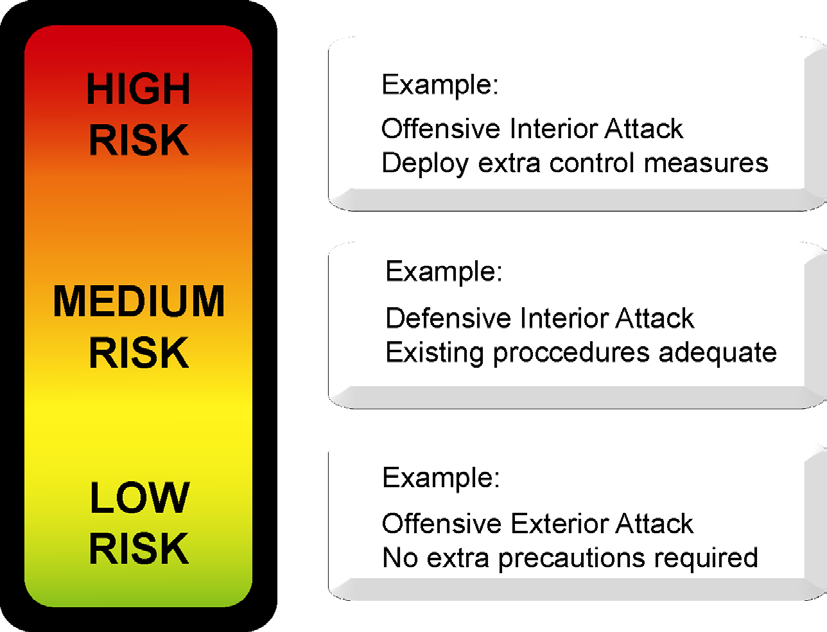 Risk Assessment, Strategy and Tactics
3.4.15 ‘Continuum of
Risk Assessment, Strategy and Tactics
3.4.15 ‘Continuum of
Given the rising level of risk (likelihood and consequence) that would normally
risk’
be associated with the move from defensive to offensive tactics, we must think
of the tactical options as closely aligned to the deployment of any control
measures to mitigate the risk. Clearly, the balancing of risk and the mitigating
control measure will need to be increasingly acute as the OIC moves toward a
decision for offensive interior attack. This concept is illustrated at Figure 3.7
below.
Act
Information
Official
the
Figure 3.7: Tactical ‘Risk Continuum’
(Source – NZFS 2006)
under
The last step in finalising tactics is to think carefully about the level of risk to
which firefighters will be exposed because of their deployment.
Released
January 2013
29
Incident Management – Command and Control
3.5 Safe Person Concept
3.5.1 Safe Person
The Safe Person Concept (SPC) is about thinking and acting safely. In your
Concept
role as a firefighter, you will be faced with hazards that could cause serious
harm or injury. You will need to be aware of potential hazards and make
decisions that will keep you, your crew, and the public safe. The SPC will help
you to do this successfully.
Act
The SPC involves all the things needed to do the job safely. This includes:
• maintaining ‘situational awareness’ (knowing what is going on around
you)
• being aware of hazards
• making decisions to reduce risks
• making decisions about what risks are acceptable
• using Dynamic Risk Assessment (DRA)
Information
• being prepared for unexpected changes
• following operational procedures
• taking direction from your officer
• being trained to do the tasks assigned to you
Official
• using personal protective equipment (PPE)
• using the right equipment for the tasks you perform.
the
The SPC underpins everything you do in the NZFS. It is the principle of
‘safety first’.
under
Released
30
New Zealand Fire Service – National Training
Risk Assessment, Strategy and Tactics
3.5.2 Safe Person
Concept overview
The principle of ‘Safety
First’
PEOPLE
HEALTH and SAFETY
Knowledge
Hazard identification
Skill
Risk assessment
Attitude
Hazard controls
Act
Training
Risk management
Responsibilities
Dynamic Risk
Assessment
PROCEDURES
EQUIPMENT /
Planning
RESOURCES
Risk analysis
Integrated PPE
Tactics/tasks
Firefighters/crews
Operational instructions
The right tools for the job
Command and Control
Likelihood/consequence
assessment
Information
Official
Figure 3.8: Safe Person Concept overview
the
3.5.3 Levels of
responsibility
At an incident, there will always be an Officer in Charge (OIC). The OIC will
decide on the right people for each task, the procedures to follow, and so on.
They will do as much risk management planning as is practical to make sure
the job is as safe as possible for you and your crew.
under
However, it is important that you don’t ever just blindly follow instructions.
Sometimes you may see a hazard your OIC missed, or you may identify a new
hazard when your OIC is not nearby. Using the SPC, you will make the
decision on how to proceed, so that you can do the job as safely as possible. At
times, you may decide not to continue with a task if it is too unsafe to do so.
You are responsible for safety at three levels:
Released
Task level
doing the job safely
Team level
helping to ensure the safety of those you work with
Individual level
ensuring personal safety, e.g., wearing correct PPE
Officer level responsibilities are also set out below.
January 2013
31
Incident Management – Command and Control
3.5.4 Task level
You need to ask yourself:
• what does it take to do this task safely?
• have I been trained to do it (e.g., procedures/skills)?
• what equipment will I need (e.g., correct PPE, breaking and entry tools,
fire extinguisher, hose deliveries)?
• do I need help with the task (e.g., when lifting heavy equipment)? Act
Be careful not to be totally task-focused, because this creates the possibility of
individual or team safety being ignored because of the drive to get the job
done.
3.5.5 Team level
The team approach to incidents is the basis of how NZFS operates. Each crew
is a team, with each member of the team having a role to play. There will be a
variety of skills and experience in the team, and the OIC will take these into
account when allocating tasks.
Members of a team must develop a high degree of trust in each other and must
also take responsibility for watching out for each other.
Information
3.5.6 Individual level
Your responsibilities are to:
• be aware of hazards
• assess the risk for all tasks you perform
Official
• adapt to changing circumstances
the
• use training do the job safely
• work with equipment safely
• work within NZFS systems and procedures
under
• be an effective team member
• identify when you are not trained/skilled for a particular task
• be vigilant regarding personal, team, and public safety.
To be safe, individuals must accept responsibility for safety at all levels.
An individual who takes needless risks endangers not only themselves but also
Released their crew, who may have to step in to rescue them. This may also affect the
ability of the team to complete the task (by drawing resources away from that
task).
32
New Zealand Fire Service – National Training
Risk Assessment, Strategy and Tactics
3.5.7 Officer level
The OIC is responsible for risk assessment and risk management at an incident.
The OIC will rely on a number of tools to help manage risks, such as:
• operational instructions
• Command and Control (including the overall strategy, tactics and
tasking)
• information provided by the crew
•
Act
experience
• training
• available resources and equipment
• the Dynamic Risk Assessment process.
The officer is also responsible for the safety of those involved at the incident.
An OIC must provide adequate communication, supervision and support if
Information
putting people in harm’s way.
3.5.8 Communication
Communication is an essential tool for risk assessment and risk management.
Responsibilities:
Official
• firefighters report all hazards to their officer as soon as possible
• OIC Fire communicates hazards, hazard controls and risk management
procedures, to all staff at the incident.
the
This is an ongoing process throughout the incident as the situation changes, in
some cases, from minute to minute.
under
Released
January 2013
33
Incident Management – Command and Control
3.5.9 Acceptable risk
There are limits to the level of risk that you and the NZFS are expected to
accept and times when we will, and will not, risk our safety.
Acceptable risk
In a highly considered way, firefighters:
•
will take some risk to save saveable lives
•
may take some risk to save saveable property
Act
\ •
will not take any risk at all to try and save lives or properties that are
already lost.
Source - HM Government, Fire and Rescue
Manual, Volume 2, Fire Service Operations,
Incident Command, 3rd edition 2008
Information
The cardinal rule of rescue is ‘do not become a victim’.
3.6 Dynamic Risk Assessment
3.6.1 Dynamic Risk
To keep safe, you will need to manage the risks on the incident ground, even
Official
Assessment overview
when the situation is changing rapidly. This is called Dynamic Risk
Assessment (DRA).
DRA is an important part of the SPC, because you will encounter situations
the
when hazards arise that were not planned for, that are outside of your training,
and that need immediate response.
Dynamic risk assessment involves four main steps at recruit level:
1. identifying hazards
under
2. assessing the risk presented by hazards
3. identifying options to reduce the risk
4. deciding if the risk is acceptable or not acceptable.
Note: At officer level, DRA is used to decide on tactics and tasking at a
rapidly changing event.
Released
34
New Zealand Fire Service – National Training
Risk Assessment, Strategy and Tactics
Step 1: Identify hazards
The first step is to be aware of existing hazards and identify the potential for
unforeseen ones.
To apply the Safe Person Concept you must always be looking out for hazards.
This is true for any incident you respond to, whether it is going according to
plan, or whether it is a dynamically changing situation.
Just as you look both ways before crossing the road, you should always look
for potential dangers in your immediate working environment.
Act
Examples of common hazards include, but are not limited to:
• traffic
• heat
• electricity
• smoke
• environment
Information
• falling debris
• weakened structures
• people
Official
You must notify your OIC of hazards identified.
the
Step 2: Assess the risk
Once you have identified a hazard, you must assess how serious the risk is.
This will help you to decide what steps to take to reduce the risk.
The Risk Matrix, set out in the following section, is a useful tool for assessing
the risk.
under
Step 3: Identify options
If your OIC is not available, you may need to take action to reduce the risk
to reduce the risk
before you can proceed with the task.
Think about how you can eliminate, minimise or isolate the hazards to reduce
the risk. You may be able to lower the risk by reducing the likelihood and/or
consequence of something happening.
For example, when handling hot lights, you can minimise the likelihood
Released (chance) of getting burned, by wearing gloves.
January 2013
35
Incident Management – Command and Control
Step 4: Decide if the risk In an emergency incident it will not be possible to completely eliminate all
is acceptable
risk. Rather, with any particular hazard, risk assessment is about identifying
what risk is acceptable before proceeding with a task.
As a firefighter, you would not want to enter into a high risk situation, unless
there is no alternative. Before proceeding, you will need to consider whether
or not the existing risks are acceptable. Remember, we:
•
will take some risk to save saveable lives
•
may take some risk to save saveable property
Act
•
will not take any risk at all to try and save lives or properties that are
already lost.
3.6.2 DRA for OICs
As discussed above, recruits assess rapidly changing risk using a process
known as Dynamic Risk Assessment. This process is also used by OICs.
Your OIC will make decisions according to several risk management planning
techniques, including the Dynamic Risk Assessment process. The DRA
process flowchart is shown below to give you a picture of how decisions are
Information
made at a higher level.
Official
the
under
Released
36
New Zealand Fire Service – National Training
Risk Assessment, Strategy and Tactics
3.6.3 DRA process
flowchart (OIC level)
Identify objectives and
hazards
Assess risk
Act
Select strategy
Consider
AND tactics
alternatives
Carry out risk
assessment of
tactics
Information
Are the benefits
Implement control
worth the risk?
measures and
reassess tactics
Official
Yes
No
Select tasks
the
Can additional
achieve tactics
control measures
be introduced?
Yes
under
No
Proceed with tasks
DO
NOT PROCEED
(continual process)
Figure 3.9: Dynamic Risk Assessment model
Released
January 2013
37
Incident Management – Command and Control
As part of the scene size-up, the OIC will evaluate the tasks that need to be
undertaken and the risks associated with those tasks. The OIC will then select
tactics using DRA, and will only apply the tactics when the benefits are worth
the risk.
When carrying out a DRA, it may not be practical to take the time to formally
apply the risk matrix to assess the seriousness of the risk, then apply the DRA
process, and if the benefits are not worth the risk to introduce and implement
additional control measures and the reassess your tactics.
Act
Familiarity with applying the risk matrix in controlled situations, such as
training or discussion with others will help build your knowledge of the steps
in the process and confidence that in a rapidly changing situation, you can
apply new controls knowing that the risk is reduced and your tactics have
resulted in safer tasking.
3.6.4 Likelihood x
At times, you may be required to put yourself at some risk to carry out required
consequence = risk
tasks. The Risk Matrix is a visual tool to give you an idea about how to assess
the seriousness of a risk.
Information
‘Likelihood x Consequence = Risk’ is a way of thinking. In every response
situation, a firefighter must be actively thinking about potential hazards in
terms of likelihood, consequence and risk.
Likelihood
the chance of something happening
Consequence
the outcome or impact if it does happen
Official
Risk
this is the chance of something going wrong
The OIC will carry out the initial risk assessment at an incident. Then they will
the
select the tactics and tasks that will reduce the likelihood and/or consequence
of hazards, to reduce the risk.
Likelihood
Likelihood is the
chance, frequency or
probability that something will happen.
For example, if a car is approaching as you cross a road, there is some
under
likelihood that you could be hit.
Every day people safely cross the road. The likelihood of being hit is ‘rare’,
provided the risk is minimised by crossing while the car is still a safe distance
away.
Consequence
Consequence is the outcome or impact of something happening. A
consequence could be financial, operational (damage to equipment, impact on
strategy), personal, physical or psychological.
Released With the example above, a consequence of being hit could be physical injury.
Depending on the impact, the physical consequences could be minor,
moderate, major or catastrophic. Even if the physical consequences are minor,
the psychological consequences could be major.
38
New Zealand Fire Service – National Training
Risk Assessment, Strategy and Tactics
Risk
Risk, in the context of dealing with an emergency incident, is about the danger
involved. To understand the overall risk, the likelihood of something
happening must be considered along with the consequences it would have if it
did happen.
The decision you make about when to cross the road is based on the level of
risk you are prepared to take. By looking both ways before crossing the road,
you can lessen the risk of injury, by reducing the likelihood of being hit. The
consequences of being hit are affected by other factors, like the speed of the
car.
Act
3.6.5 Categories of
The following tables describe likelihood, consequence and risk.
likelihood
LIKELIHOOD
Descriptor
Description
The chance of something
happening
Almost
Is expected to occur
Greater than a 90% chance of
certain
occurring
Likely
Will probably occur
Between a 70% to 90% chance
Information
of occurring
Possible
Might occur
Between a 30% to 70% chance
of occurring
Unlikely
Could occur
Between a 10% to 30% chance
of occurring
Official
Rare
May occur in
Less than a 10% chance of
exceptional
occurring
circumstances
the
3.6.6 Categories of
CONSEQUENCE
consequence
Descriptor
Examples*
Catastrophic
Fatality(ies) to staff; catastrophic loss of operational
under capability (e.g., three appliances out of use)
Major
Multiple serious injuries (e.g., permanent disability);
major loss of operational capability (e.g., loss of one
appliance)
Moderate
Serious injury (e.g., hospital, off work); moderate
loss of equipment (e.g., broken ladder)
Minor
Minor injury; minor loss/damage to equipment (e.g.,
standpipe knocked out of ground)
Released Insignificant Insignificant injury or damage/loss to equipment
(e.g., burst length of hose)
*Descriptions in this table relate to the degree of injury or loss of operational
capability. Consequences may also occur in other context (e.g. financial, loss
of reputation, public image).
January 2013
39
Incident Management – Command and Control
3.6.7 Risk Matrix
The matrix below can be used to assess the risk associated with the likelihood
and consequences of an event. Risks with the highest ratings should be dealt
with first.
In an emergency incident, you will not be referring to the risk matrix to make
decisions. But, it is important to understand the concept. The higher the
likelihood and consequence, the greater the risk.
For example, if a hazard presents a high likelihood of causing a problem, and
the consequences would be high, you must consider the risk very high and take
the appropriate steps to manage the risks.
Act
CONSEQUENCES
LIKELI-
HOOD
In-
Cata-
Minor
Moderate
Major
significant
strophic
Almost
Low
Medium
Very high
Very high
Very high
certain
Likely
Low
Medium
High
Very high
Very high
Information
Possible
Low
Medium
High
Very high
Very high
Unlikely
Low
Low
Medium
High
Very high
Official
Rare
Low
Low
Medium
High
High
the
under
Released
40
New Zealand Fire Service – National Training
Risk Assessment, Strategy and Tactics
3.6.8 Example
The following example demonstrates the Dynamic Risk Assessment at work.
You have responded to a garage fire in a residential area. Upon arrival you do a
risk assessment and decide to proceed with an internal attack.
The first crew in relay back that there is an acetylene cylinder in the garage.
You use the Dynamic Risk Assessment to decide what new strategy and tactics
to use (if any).
Act
Likelihood
Has the cylinder been involved in the fire?
Yes/No
• If
Yes then the likelihood of risk would be
Likely that something may
occur relating to the cylinder because of exposure to the heat from the
fire.
• If
No then the likelihood would be
Unlikely that anything will occur as
a result of exposure to the heat from the fire.
Information
Consequences
What would the consequences be if the cylinder became or was involved in
fire? In this case the consequences would be
Major/Catastrophic due to the
potential for an explosion that could cause physical injury or death.
Official
Risk matrix
For the example we will assume that the cylinder
is involved in fire. Using the
risk matrix you can see that the risk would be
Very High.
the
CONSEQUENCES
LIKELI-
HOOD
In-
Cata-
Minor
Moderate
Major
significant
strophic
Almost
under Low Medium Very high Very high Very high
certain
Likely
Low
Medium
High
Very high
Very high
Possible
Low
Medium
High
Very high
Very high
Released Unlikely
Low Low Medium High Very high
Rare
Low
Low
Medium
High
High
In this situation you would then look at ways to minimise the risk by altering
your tactics.
January 2013
41
Incident Management – Command and Control
Alternate tactics
Some alternative tactics, or control measures, you could consider that would
lessen the risk to fire crews:
• withdraw to a safe distance and apply water using monitors
• increase the number of deliveries and flow rates to reduce the fire
intensity as quickly as possible
• task additional crews to apply cooling water directly onto the cylinder.
Once an alternative tactic (control measure) has been selected, reassess the risk
against the risk matrix. If the risk is acceptable carry out the control measure.
Act
3.7 Snap rescue
3.7.1 Definition
"Snap rescue" is defined for the purposes of NZFS operations as:
"A rescue that is initiated in exceptional circumstances, where time or other
Information
imperatives demand that immediate action be taken, without putting in place
the controls or safety measures that would normally be essential for the
incident type."
The primary driver for snap rescue is usually time - that is - if rescue is not
carried out as soon as possible, the victim's life may be at risk or their health
may rapidly deteriorate. Official
3.7.2 Snap rescue
Situations where the OIC may decide that snap rescue is an option include:
situations
• a rapidly developing fire
the
• impending risk of structural collapse
• a HazMat incident where victims are already incapacitated and the
threat from the hazardous substance is escalating (see example below)
• other threats to persons that are within scope of NZFS training
under
Note: 3.4.11 describes "offensive interior unsupported rescue" as a tactical
option. This allows for snap rescues within structures.
Example
A hazmat example of snap rescue is:
An ammonia leak at an ice cream factory - a worker has collapsed after being
incapacitated by the fumes and their life is in danger unless they are removed
Released immediately. Two firefighters perform a snap rescue in BA and level 2 PPE
(normal operations would involve two firefighters entering the area dressed in
level 4 gas suits).
42
New Zealand Fire Service – National Training
Risk Assessment, Strategy and Tactics
3.7.3 Safety and risk
All NZFS personnel involved in a snap rescue will apply the Safe Person
assessment
Concept at all times.
In all instances the OIC will carry out a dynamic risk assessment, to determine
if the risk to the rescuer(s) is acceptable. Factors that the OIC needs to consider
when deciding on a snap rescue include:
• the ability to implement tactics that may reduce the risk to personnel
• the condition of the patient
• whether the location of the patient is known
Act
• the potential arrival time of additional resources
• communication and/or visual contact with the rescuers and the OIC
• distance to be travelled in the "hot zone" or "fire and/or rescue zone"
• experience and/or training of the rescuers.
Note: Snap rescue will not be undertaken if the location of the patient is not
known. In addition, no search is to be carried out beyond the expected location.
Information
3.7.4 Implementation
If the OIC determines that the risks of the attempted snap rescue are
acceptable, variations to the search and rescue procedure and/or normal PPE
wearing requirements may be directed to enable the rescue to be carried out
within an urgent timeframe.
Tasking must include precise instruction for the rescue crew, detailing:
Official
• the tactics required to effect the rescue
• what procedure and PPE differs from normal practice.
the
under
Released
January 2013
43
Incident Management – Command and Control
3.8 Sectorisation
3.8.1 Definition
Linked directly to the need to minimise risk is the need for effective spans of
control on the incident ground. Increasing complexity is inevitably
accompanied by a matching reduction in the OIC’s ability to maintain effective
command. This is not only inefficient in terms of delivering the Agency Action
Plan (AAP) – it is also potentially dangerous. The OIC must always be
prepared to break the incident into sectors, each with its own command, thus
Act
allowing him/her to focus on the bigger picture. This process is known as
sectorisation.
3.8.2
Sectorisation therefore is the organisation of the incident ground, by the OIC,
into distinct areas of work in order to manage the whole incident more
effectively and to ensure the safety of all those involved in dealing directly
with the incident.
3.8.3 Types of sector
Two kinds of sector may be created:
1. Operational sectors i.e. areas where work is going on directly to bring
Information
the incident under control – firefighting, rescue, exposure protection,
salvage, ventilation. This type of sector can be geographical, e.g.
‘Sector 1,’ or functional, e.g. ‘Search & Rescue’ or ‘Ventilation’
2. Logistical sectors, i.e. areas established to provide materials and
processes required to sustain ongoing operations – BA
recommissioning, water supply, foam supply, decontamination, canteen
Official
facilities etc.
Naturally, in a level 2 or level 3 incident other agencies may set up and run
their own operational and support sectors, e.g. triage, medical re-supply,
the
evacuation etc.
under
Released
44
New Zealand Fire Service – National Training
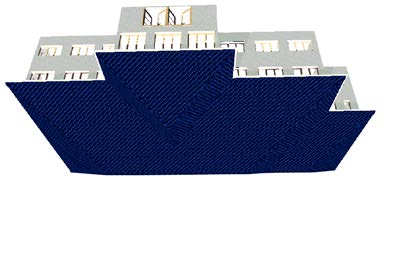 Risk Assessment, Strategy and Tactics
3.8.4 Guidelines for
Risk Assessment, Strategy and Tactics
3.8.4 Guidelines for
The general principles are as follows:
establishing operational
sectors – buildings
• The standard arrangement is to number sectors clockwise from the
front of the building. Since most buildings have four sides, this usually
results in each side being recognised as a potential sector
• Sector 1 commonly serves the ‘front’ of the building. If the building
has no obvious front, the Incident Controller should designate the
location and if appropriate, mark it. Once Sector 1 is established any
incoming personnel can then orientate from that sector. (i.e. ‘Sector 1,
Willis Street’)
Act
• The other sectors are allocated to the remaining sides of the building in
a clockwise manner as shown in Figure 3.10
• The identification of a sector should be further clarified by the addition
of obvious descriptors if this assists, e.g. ‘Sector 2 – west side’ or
perhaps ‘Sector 3 – Palmerston Road side’.
3.8.5 Alternative
Most incidents will not require all four sectors to be set up and activated. In
sectorisation
these circumstances, the OIC may use any of a range of variations on the
standard sector ‘grid’. The most commonly used variants are shown overleaf at
Information
Figures 3.11 – 3.13. Incident Ground SitReps will also communicate to all
staff how many sectors are in operation.
Official
Sector 3
the
Sector 2
Sector 4
under
Front of Building
Sector 1
Figure 3.10: Standard allocation of sectors
Released
January 2013
45
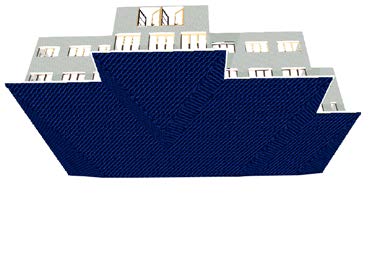
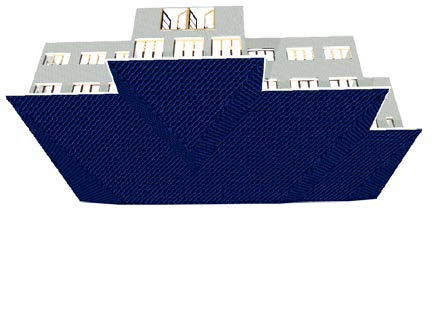
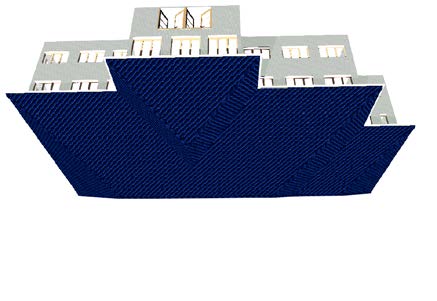 Incident Management – Command and Control
Incident Management – Command and Control
Sector 3
Sector 3
Act
Front of Building
Sector 1
Figure 3.11: Common variation on standard sectorisation
Sector 3
Sector 3Information
Official
the
Front of Building
Sector 1
Figure 3.12: Common variation on standard sectorisation
under
Sector 3
Sector 3
Sector 4
Released
Front of Building
Sector 1
Figure 3.13: Common variation on standard sectorisation
46
New Zealand Fire Service – National Training
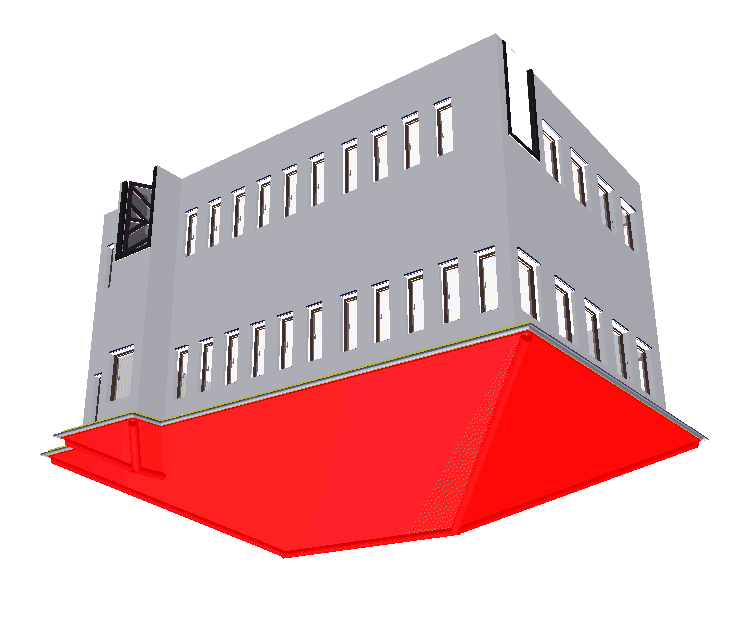


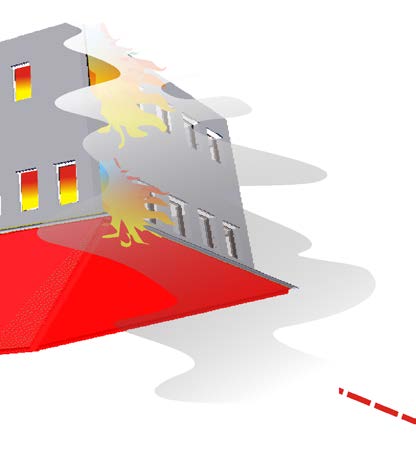 Risk Assessment, Strategy and Tactics
3.8.6 Sectorisation of
Risk Assessment, Strategy and Tactics
3.8.6 Sectorisation of
Incidents where fire may have involved floors above (or below) may be
fires on several floors
sectorised using any appropriate variant plus a floor/level descriptor, e.g.
Sector 1 level 2. This is illustrated at Figure 3.14 below.
Sector 3
Act
Information
Figure 3.14: Example of sectorising with fire on more than one level of a building
(Source – NZFS 2006)
Official
the
under
Released
January 2013
47
Incident Management – Command and Control
3.8.7 Location of
This is essentially a matter of common sense. The guiding principles must
logistical sectors
always be:
• Safety of sector personnel – the sector should not be established so
close to the event that they are directly affected by it or its potential
development. Wherever possible, logistical sectors should be located
upwind of any fire or hazardous substance spillage
• Incidents occurring on public highways pose particular threats to
personnel. The OIC must ensure (preferably by using the Police) that
traffic flow is not allowed to threaten those working in a support sector
Act
• Efficiency – ensuring ease of access and minimising distances that
personnel and materials need to be moved
• Optimising command – it is not essential that the sector has line of
sight with the ICP, but the OIC must ensure that radio communications
will function effectively, e.g. there are no dead ground or
screening/interference factors.
3.8.8 Guidelines for
Generally, motor vehicle accidents do not need to be sectorised. However, in
sectorising MVA
the event of multiple collisions or collision-related emergencies, it may be
Information
incidents
necessary to sectorise in order to maintain an effective span of control. This is
illustrated at Figure 3.15. Generally however, it is easier to sectorise by
function or vehicle description.
Official
the
under
Released
48
New Zealand Fire Service – National Training
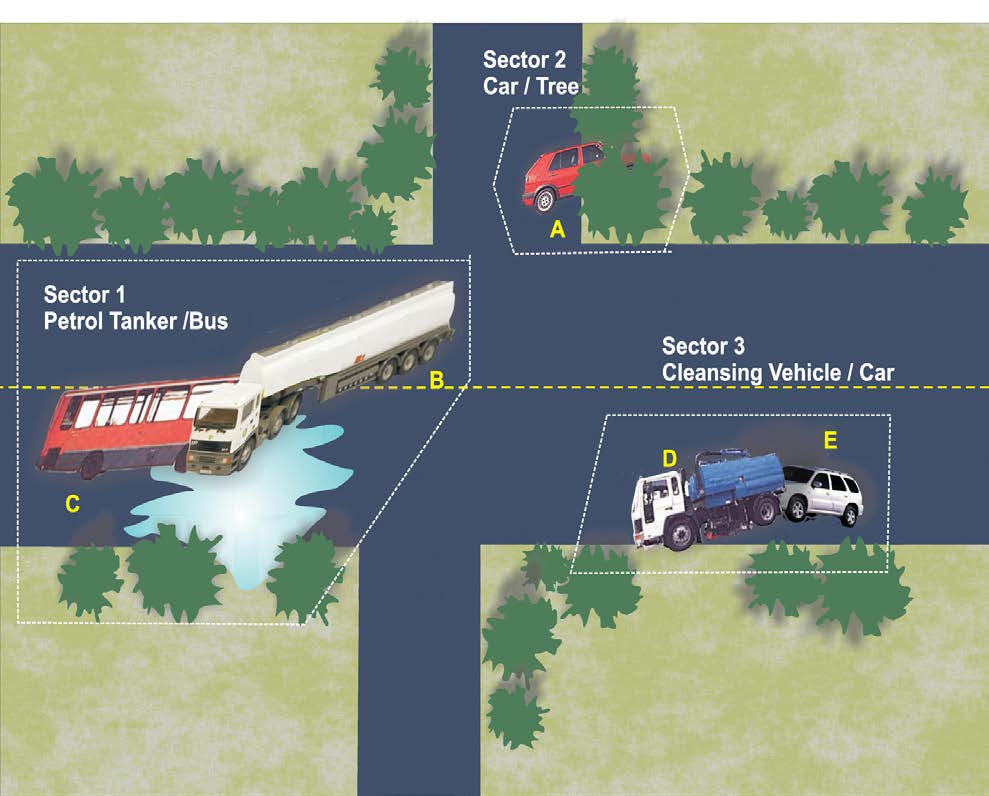 Risk Assessment, Strategy and Tactics
Risk Assessment, Strategy and Tactics
Act
Information
Official
Figure 3.15: Example of sectorisation at a multiple motor vehicle accident
the
(Source – NZFS 2006)
3.8.9 USAR incidents
Urban search and rescue incidents utilise a different approach to sectorisation.
Please refer to the USAR Awareness Training Manual for further guidance.
under
Released
January 2013
49
Incident Management – Command and Control
3.9 The NZFS Agency Action Plan (AAP)
3.9.1 Rationale
This is largely a matter of common sense. To respond to emergency situations
without some degree of planning is to invite disaster. Clearly, the greater the
scale of an incident, the greater the need for comprehensive planning.
However, even the simplest incident requires thought before action.
3.9.2
Act
In summary, the purpose of an AAP is to provide a common understanding of
intended actions for everybody in the chain of command by:
• Defining the AIM/objectives for the incident or for the coming
operational period
• Defining the STRATEGY and TACTICS selected to meet those
objectives
• Defining the operational TASKING of deployed resources
• Defining the resources required to accomplish assigned tasks
Information
• Describing the command structure in place
• Defining required communications via a communications plan
• Identifying significant risks and the methods taken to reduce them
• Providing a current situation analysis
• Providing adequate mapping/location guides
Official
• Providing an efficient means of briefing and handover to relief crews or
the owner/owner’s representative (refer to Section 5.4.3)
the
• Providing a tangible record of events for any subsequent operational
debrief.
under
Released
50
New Zealand Fire Service – National Training
Risk Assessment, Strategy and Tactics
3.9.3 Application
The development of an AAP should follow size-up and risk assessment of
selected tactics, and should be done for all incidents. For a small scale incident
there is rarely any need to go to the lengths of a written plan. As a guide, the
OIC Fire should consider going to written documentation for a second alarm,
when there are more than five pumps or an incident command unit is in
attendance.
3.9.4 Associated risk
The AAP should assess and document any identified risks and methods used to
assessment
mitigate them. The dynamic risk assessment matrix (Safe Person Concept)
Act
should be used for this purpose. The AAP template provides a section for the
risk assessment to be documented.
It is especially important for any significant risks to health (e.g. suspected
presence of asbestos) to be documented so that they can be followed up
through monitoring of personnel and cleansing of equipment.
3.9.5 CIMS environment On those occasions when the NZFS is the lead agency and provides the
Incident Controller, he/she may need to consolidate the action plans forwarded
by other agencies into what would be a CIMS IAP. This issue has been dealt
Information
with in greater detail in Section 2.5.4.
3.9.6 Fire Service
As previously noted, the majority of small-scale, routine incidents need little or
Command System –
no planning – they can be dealt with adequately on the basis of common
scalability of
experience (recognition primed decision-making).
AAP/command tools
Official
3.9.7
Apart from such commonplace incidents however, the OIC should always
engage positively with the NZFS Agency Action Planning process (see Figure
the
3.4). It is recognised that there is a need for different scales of planning
appropriate to the nature of the incident. The command system planning system
intends to use three tools currently under development to match the range of
planning needs. These are:
• ‘Level’ 1 – OIC’s field notebook or Aide de Memoir: sufficient for
under
1st/2nd alarms
• ‘Level’ 2 – Incident Command Pack – sufficient for 3rd/4th alarms (to
be developed)
• ‘Level’ 3 – Incident Control Unit on-board manual or electronic (eIAP)
Incident/Agency Action Plan systems– intended for the management of
major incidents.
Released
January 2013
51
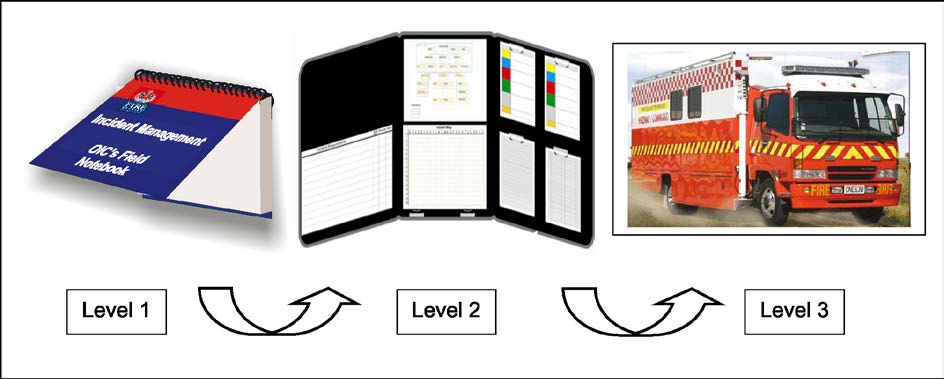
 Incident Management – Command and Control
3.9.8 Allocation of
Incident Management – Command and Control
3.9.8 Allocation of
It is envisaged that the field notebook will be of use to all officers on a regular
IAP/command tools
basis and be used initially for the majority of larger or developing incidents.
The level 2 command packs will be strategically located for deployment at
larger incidents while awaiting the arrival of an Incident Command Unit.
Command Units will be located in the larger Districts and their systems
operated by trained personnel.
N.B. For details relating to the IAP tools outlined above please refer to Annex
Act
A to this manual ‘Planning Tools’.
Information
Official
Figure 3.16: Levels of incident action planning tools in the Fire
Service Command System
(Source NZFS 2006)
the
3.9.9 Continuity of
It is important to understand that while three levels of planning tools are
method
provided, they are linked by common principles. The difference in levels is a
reflection of increasing depth – not of varying technique.
under
Released
52
New Zealand Fire Service – National Training
Risk Assessment, Strategy and Tactics
3.9.10 Standard
AAPs at all three levels should address and document the following standard
components
areas of concern:
• Incident location
• Incident organisation chart
• Brief description of incident
• AIM and STRATEGY
• Selected TACTICS – including any make up
Act
• Operational TASKING – to be constantly amended as incident
progresses
• Communications plan
• Incident sketch map – with grid referencing if warranted by
scale/complexity of ground
• Hazard management plan.
3.9.11 Example AAP –
Shown overleaf at Figures 3.17 – 3.20 is an example of a completed AAP
Information
level 1
using the appropriate consumable forms from the level 1 or 2 OIC’s Aide de
Memoir or Field Notebook (final design pending). This incident is sufficiently
complex to warrant a documented approach. Incidents any larger than this
would certainly benefit from the use of the command pack.
Note that this level requires no more than the AAP aide memoire pack. It is
ideal for use when managing an incident from an initial arriving appliance.
Official
Allocation of radio channels will depend on local arrangements. This example
illustrates the basic concept and structure that would be followed, in an
expanded fashion, at the higher levels.
the
Communications will be dealt with in greater detail in the next section.
under
Released
January 2013
53
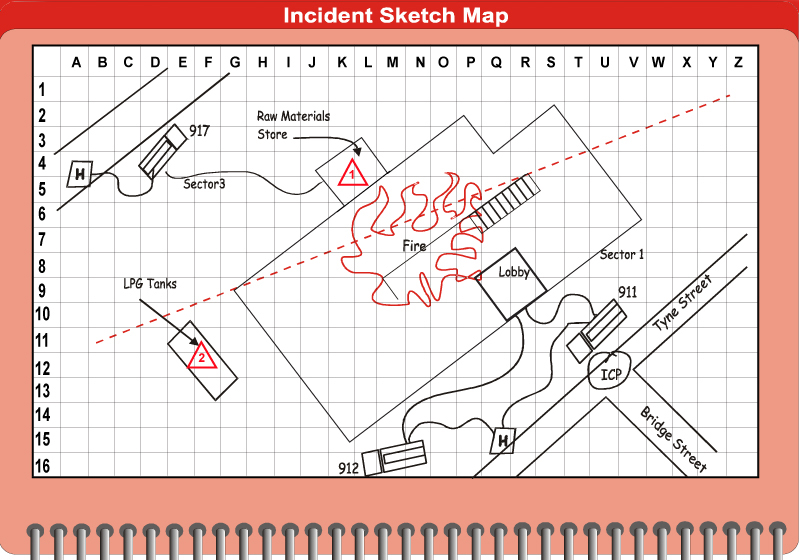 Incident Management – Command and Control
A
Si
At m
rat:
megy
Incident Management – Command and Control
A
Si
At m
rat:
megy
Protect life and property.
Prio rity 1: Ensure evacuation complete including rescue as required.
Priority 2: Extinguish fire. Minimise damage to property and environment
StPr
r at
ior eg
ity 3 y:
: Monitor Ha P
zr
Sio
u r
bsity
is s1
u:
eE
s n
–s
u
fure
meev
s a
fr c
oua
m t
si
to
on
r c
e o
e m
tc p
. lete including rescue as required.
Pr
Tio
a r
ci
tt
iy
c 2
s : Extinguish fire. Min
1i
.m
S is
ece
tod
riama
se c g
l e
oc t
k o
w ip
sro
e fp
r er
o t
m y
T an
yn d
e Sen
t evi
n r
t o
r n
a m
nc e
e.n
It.
CP adjacent to gate.
Pr
ior
2. i
2 t
y
x 3
B :
A Mon
tea i
m t
s or
en H
te a
r z
t S
hrub
ous i
ghs
lsu
o e
b s
b -
y ( fu
secm
t e
ors f
1) r
. om
1 t
e s
ator
m t e
o e
p t
r c
o .
t ect stairwell from advancing fire (passive interior
Tact
a itcs:
tack) 1 team t o 1
c.
aS
re
r c
y to
o r
u i
tse
S c
& l
Roc
o kw
f t i
os
pe f
fl r
o o
om
r Tyne Street entrance. ICP adjacent to gate.
3. On completion
o f rescue BA teams withdraw. 1 team redeploys for fire attack from sector 3. 1 x Pumps in sector
2. 2 x BA teams enter through lobby (sector 1). 1 team to protect stairwell from advancing fire (passive interior attack)
1 to redeploy to sector 3.
1 team to carry out S & R of top floor.
4. Cooling of materials store from interior while awaiting completion of rescue.
Act
5. Once S&R completed, aggressive interior attack through sector 3 to push fire away from materials store and
4
. Cooli
L ng of
PG. materials store from interior while awaiting completion of rescue.
5
. O
6. n
Ice
nc S
o &
m R
i ncom
g r ple
eso t
u e
r d
c ,
e ag
s t g
o re
asss
si i
sv
te in
witte
h r
pio
r r
o ta
et
ct
ta
ic
o k
n t
oh
fro
e u
x g
p h
o ss
ue
rc
et
sor
(L 3
P t
G o p
) a u
n s
d h
f if
ri
ere
a ta
tw
a a
c y
k f
a r
so
r m
e qm
ua
irte
e r
d.i
als store and LPG.
6. Incoming resources to assist with protection of exposures (LPG) and fire attack as required
Resources required – make up to 2nd alarm
Resources required - make up to 2nd alarm
Hazard Management
Hazard Management:
No.
Hazard Description
Location
Grid
Control Measure
No.
Hazard Description
Location
Grid
Control Measure
1.
Volatile plastics – materials store
NE corner
H3
Cooling + pushing fire back as
Cooling + pushing fire back as soon as
1. Volatile plastics - materials store NE Corner H3
soon as resources al ow
r
e
so
u
rces allow
2.
2 . LP
L G t
PG tan
a ks
nks West side
West
si
de D8/9 C
D8 o
/ o
9 ling a
C s so
oolion
n as r
g a eso
s soour
n ce
a s a
s r l
elow
sources
allow
Information
Figure 3.17: Example of action plan form from OIC’s field notebook
Official
the
under
Released
Figure 3.18: Example of incident sketch map form from OIC’s field notebook
54
New Zealand Fire Service – National Training
Risk Assessment, Strategy and Tactics
y
o
r
d
No
t
ri
t
w
o
d
k
Team
T k
a e
s :
ked
e
c
Task
Ta
Location
s
sk
Location
Team +
i
i
e
in
s a
t
S
r
r
P
G
Grid R
i
L Leade
eader r
r
Sector
C
a
T
a t
Crew
:
1
Top floor
1
M 1 - SFF Johns 2
1135
1
S&R
Top floor
1-SFF Johns
2
11:35
1
Protect escape route
Lobby and stairwell
1
K5
K5 M 2 - SFF Smith 2
1135
1
S&R team
Lobby and stairwell
K6 K6 2-SFF Davis
2
11:30
3
Interior rear (north
Interior rear
2
H3 L
2 - SFF Smith 2
-east corner)
3
Protect materials store
(norht-east corner)
H3
3-SFF Smith
2
11:37
3
Aggressive interior attack Rear of building (north side)
Act
Aggressive interior attack attaRck
eathrro
o ug
f h re
buil ar e
di n
ngtra
( nc
no er th si 3
d e)
M 2 - SFF Johns 2
once S&R completed
3
once S&R completed
attack through rear entrance
4-SFF Adams
2
11:40
On arrival -cooling LPG
D8
2
On arrival – cooling LPG
Exterior west side
D8 L
4
3 - ?
2
tanks
2
tanks
D9
Exterior west side
D9
5-SFF Samms
2
?
Information
Figure 3.19: Example of operational tasking form from OIC’s field notebook
Official
INCIDENT CONTROLLER
CIMS SAFETY
SSO Black
the
CIMS PLANNING & INTEL
CIMS OPERATIONS
CIMS LOGISTICS
OIC FIRE
SAFETY OFFICER( FIRE)
SSO Black
SFF Grey
FIRE PLANNING & INTEL
FIRE OPERATIONS
FIRE LOGISTICS
SSO Black
under
1
SO Brown
WATER RELAY 1
Team 1
WATER RELAY 2
Team 2
3
SO Green
Team 4
2
?
Released
Team 2 (on redeploy)
Figure 3.20: Example of command structure form from the OIC’s field notebook
January 2013
55
Document Outline
















































